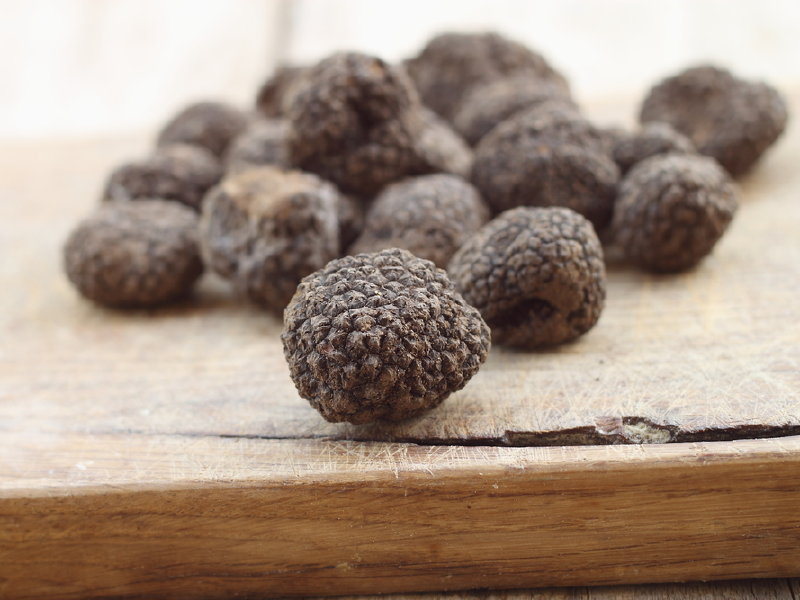Vittorio Giordano’s relationship to the truffle began 15 years ago, while he was living in Italy. He owned a company which sold food to local restaurants.
"Urbani came to me and asked me to sell truffles," Giordano explains. "And I fell in love."
Giordano now oversees 70 percent of the truffle sales in the United States as vice president of Urbani Truffles USA.
Selling for hundreds and even thousands of dollars or more per pound, truffles are among the most expensive foods in the world.
According to Giordano, truffles have maintained both a mystique and a higher price point largely because they have never been domesticated. Truffles fruit randomly near the roots of trees. They are virtually invisible to the human eye and undetectable to the human nose.
"A lot of people don’t understand the price," Giordano says. "But, it takes 18,000 people to move the product. It’s a natural product. It cannot be cultivated. For me, the truffle is not only a food at the table, it is like traveling. When you understand where it comes from, what happens between the time the truffle is in the ground to the time it is on the table … everything happens in 24 hours."
Giordano speaks the truth. The shelf life for a fresh truffle is extremely short. Comprised of 95 percent water, evaporation is the truffle’s worst enemy. Every hour a truffle is out of the ground, it loses weight. In fact, an average truffle will lose four to five percent of its weight per day.
"For us, it’s a commitment to deliver fresh product," Giordano goes on. "It’s the aroma. Everything is driven by people. We are very traditional and new concepts are driven from tradition."
Urbani’s commitment to fresh product includes working with the best modern truffle hunters available.
"What’s important are the kind of people we work with – only people with licenses. They need to care about the environment," he explains. "For example, if you find a truffle, you need to leave a portion of truffles for reproduction."
Paintings often depict truffle hunters foraging in tweed suits, accompanied by truffle-hunting pigs. And the vision isn’t without substance. The female pig’s natural inclination to dig for truffles can be traced to a testosterone-like compound within the truffle similar to androstenol, the sex pheromone in boar saliva. However, these days, most modern truffle hunters use dogs to lead them to ripe truffle beds.
"Pigs eat the product," Giordano verifies. "Dogs are treat motivated, but female pigs are attracted to the testosterone in the truffle."
Not only are dogs trainable, they have other advantages as well, including mobility. Dogs can be easily transported from place to place, either by foot or car.
In Italy, the use of the pig to hunt truffles has been prohibited since 1985 due to damage to the truffle beds caused by animals during digging. In fact, damage from over-zealous pigs often severely impacted the productivity of the harvest for years at a time.
But, why all this fuss over a product? Could it be that truffles are simply overrated?
"When someone says truffles are overrated, that’s a reaction of someone who doesn’t know what we know," Giordano explains. "Our job is to make them understand."
Helping consumers to understand what truffles are all about is the grist of Urbani’s business. Giordano and his staff travel the country, meeting chefs, educating them about his product and promoting truffles through dinners and classes. He attributes some of the misunderstanding about his product to the fact that America doesn’t have a historical connection with the truffle, or its fleeting season.
"In Europe, the truffle is a tradition. In Umbria in summer, everyone has truffles in their fridge."
In America, the truffle is a bit more elusive.
"When I came to the U.S. seven years ago, we were mainly selling fresh truffles. I went into a lot of stores. I saw a lot of sliced, whole truffles in jars with a lot of dust," Giordano says.
So, he took his staff and went directly to the consumers to get feedback.
It turns out that close to 50 percent of American consumers think of chocolate when they hear the word "truffle."
"If the consumer doesn't understand, at the end of the day I lose," Giordano says. And he relays a story that illustrates his point.
"Recently we were sampling truffle butter on bread. A woman asked me why we put chocolate in the butter. That woman represents the consumer in the U.S. We saw that there was a gap to cover."
In response, Urbani created a brand new line of products which made the truffle more accessible to American consumers. Canned truffle sauces include a small percentage of truffle, paired with common ingredients like tomatoes and artichokes, with easy to follow instructions for using the products with breads, pastas and the like.
"When they spend the money, we want them to have a good experience," Giordano says. "If they like it, they take the next step. They buy oil, they buy carpaccio."
Ultimately, some consumers make the choice to try out fresh truffles for themselves.
For consumers looking to try truffles for the first time, there are a few basics to keep in mind.
First, know the product. There are five main types of truffles: The white truffle, the black winter truffle, the Bianchetto spring truffle, the Burgundy truffle and the summer truffle.
White truffles have a relatively short season, generally late October through December. Black winter truffles appear in about mid-January and persist through end of February or slightly longer. For summer truffles, the best period is generally between mid-June and end of July. Burgundy truffles are also summer truffles, available primarily between May and August. Other truffles, like the Bianchetto, are available on a limited basis during the late winter and spring.
When shopping for fresh truffles, be knowledgeable about what you are buying. The truffle world is filled with sub-par products, many of which are imported from China.
"You can easily buy a Chinese truffle product in the U.S.," Giordano warns. "It looks like black winter truffle, but has no aroma, no taste. They grow in a different environment, and they’re sold more cheaply. But, you are not getting a deal. It’s illegal to work with the Chinese in Europe."
Don’t store fresh truffles in rice. Since truffles are prone to losing moisture and aroma, you’ll end up with a flavorless truffle and truffle-infused rice. So, this is only recommended if you’re interested in truffle risotto. And even then, it’s probably not the best idea.
Giordano suggests eating as much of the truffle you’ve purchased as you can right away.
"You want to enjoy it as soon as possible, within one to three days. White truffles you need to use right away. You can freeze black truffles, but you must understand that you lose something. You always lose something. Fat is a good way to preserve truffles. Make a simple sauce with garlic and olive oil. Then freeze it."
For home cooks, Giordano suggests simple preparations such as enhancing pasta dishes, or shaving white truffle over the top of an egg fried in butter.
Want something different and special? Giordano’s advice is to go to a restaurant.
"If it’s something you only buy every so often, you don’t want to ruin it," he says.
Special. Rare. Delicious.To the initiated, there is certainly something unquestionably exotic and seductive about the truffle. For many centuries truffles were highly coveted and consumed to enhance the amorous experience; Napoleon submitted to its sensuous charms, as did the infamous Marquis de Sade, who is said to have fed it to his sexual partners to entice them into the throes of passion.
In Renaissance Italy, it was rumored that Lucrezia Borgia and Catarina de Medici were downright addicted to the rare tubers.
But, is the truffle really an aphrodisiac?
"Yes," Giordano says with a chuckle, "But you have to eat a lot. Viagra costs less."
As a passionate champion of the local dining scene, Lori has reimagined the restaurant critic's role into that of a trusted dining concierge, guiding food lovers to delightful culinary discoveries and memorable experiences.
Lori is an avid cook whose accrual of condiments and spices is rivaled only by her cookbook collection. Her passion for the culinary industry was birthed while balancing A&W root beer mugs as a teenage carhop, fed by insatiable curiosity and fueled by the people whose stories entwine with every dish. Lori is the author of two books: the "Wisconsin Field to Fork" cookbook and "Milwaukee Food". Her work has garnered journalism awards from entities including the Milwaukee Press Club. In 2024, Lori was honored with a "Top 20 Women in Hospitality to Watch" award by the Wisconsin Restaurant Association.
When she’s not eating, photographing food, writing or planning for TV and radio spots, you’ll find Lori seeking out adventures with her husband Paul, traveling, cooking, reading, learning, snuggling with her cats and looking for ways to make a difference.



